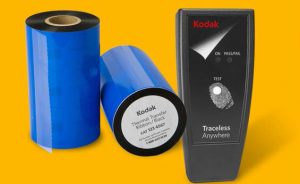Brands cannot afford to overlook the reputational and financial risks from fake products, explain regional experts providing countermeasures
Package printing stands on the front line of the fight against counterfeiting. By using new technologies printers are striving to raise the bar so high that counterfeiters cannot make money. Digital printing technologies enable converters to incorporate multiple layers of security, combining several security features into the prepress process to discourage those looking to make or sell counterfeit products.
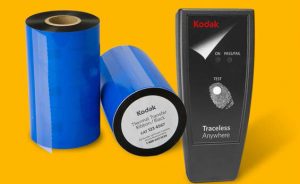 The proliferation of counterfeiting requires brand owners and their converters and printers to work together to create a multilayered protection.
The proliferation of counterfeiting requires brand owners and their converters and printers to work together to create a multilayered protection.
Ranesh Bajaj, managing director of Vinsak Dubai, which supplies brand protection and anti-counterfeiting products for packaging printers, said that recent raids in the Middle East had uncovered more than 15 million forged products.
“Counterfeiting is a big menace all across the globe,” he told Packaging MEA. “Almost every economy is vulnerable to its effects, losing billions in taxes and affecting millions of people with duped products. Governments every year create new frameworks and policies to tackle the counterfeiting but none is able to completely stop this illegal trade.
In Dubai, more than 12 million counterfeit mobile phones, mobile accessories, cosmetics, cigarettes, and foodstuff valued at more than AED327.4m were seized by the Department of Economic Development (DED) between January and September 2016.
In Qatar an investigation involving Interpol led to the confiscation of 140,000 illicit products in March this year. The fake items included car parts, tobacco products, cosmetics, mobile phones, and household appliances. In the probe, 147 people were placed under investigation.
Saudi Arabia’s ports seized over 125 million fake goods in 2015 and the kingdom’s Ministry of Commerce has found counterfeit ink cartridges, shampoo, and beauty products.
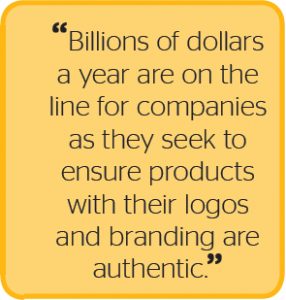 Bajaj describes brand protection or security packaging as a niche market that is growing healthily in all parts of the world including the Middle East. “Brand owners continue to invest into protecting the image of the brand from counterfeits while using these technologies to add shelf appeal as well to their products,” he said.
Bajaj describes brand protection or security packaging as a niche market that is growing healthily in all parts of the world including the Middle East. “Brand owners continue to invest into protecting the image of the brand from counterfeits while using these technologies to add shelf appeal as well to their products,” he said.
He highlights how valuable the niche can be to converters, boosting their top line and deepening their clients’ loyalty.
“For converters, the addition of security features allows them to add value to the product, which increases both their top line as well as the bottom line. It also allows them to have a much closer and stronger relationship with their customer, as competition is less in this niche field. Also once a brand owner shares critical security features with a converter, normally he will not switch vendors so easily.”
But the technology also presents converters with challenges, including “continuous innovation” to keep products resistant to counterfeiting. “While a number of technologies are available in the labs, practically implementing them on the production process involves large investments in plant and machinery as well as adding steps in the production process,” said Bajaj. “Usually, these processes are complex and require a higher skill level from the operations team as well. Converters who have been able to master new technologies and deploy them successfully have been able to reap windfall profits.”
Brand owners, meanwhile, must balance security with costs. “Getting the ROI of any or each additional feature is a challenge and keeping the packaging secure continues to be a challenge. Needless to reiterate, the motivation and profits of the counterfeiter are always much higher than the original manufacturers as his returns are higher.”
Another challenge is that many brand owners do not wish to acknowledge any counterfeiting issue. In many cases, they fear harming their brand by losing public trust. “However, this is much like the pigeon closing his eyes to the cat and wishing it to go away,” said Bajaj. “A robust brand protection strategy combined with clear and effective customer communication is what the brand owner should opt for and in the mid to long term, this will for sure reap good results.”
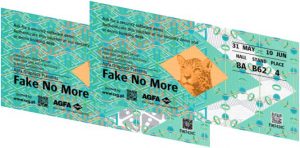 Vinsak, as a supplier of protection technologies, is under constant pressure to innovate new products, make them commercially viable for the converter, then deploy and train the converter, and then monitor the effectiveness of the technology, he added.
Vinsak, as a supplier of protection technologies, is under constant pressure to innovate new products, make them commercially viable for the converter, then deploy and train the converter, and then monitor the effectiveness of the technology, he added.
“This involves a lot of effort both technically and financially. The problem gets compounded by the short life cycle of such technologies as counterfeiters catch up fairly quickly and also the ‘wow’ factor of the technology wears off very fast.
Hence constant innovation with a practical hands-on approach to the problem is our only success mantra.”
A Smithers Pira report on anti-counterfeiting highlights how the extension of trade zones has facilitated the movement of counterfeit goods across borders. But technology suppliers are responding with product authentication and consumers, brands, and enforcement authorities increasingly using mobile digital channels, such as smartphones to authenticate items.
Food is the largest end-use market for brand protection accounting for a projected 38.8% market share in 2017. Industrial is second, followed by other consumer goods. The market for brand protection is forecast to register moderate growth to 2022 across all end-use markets examined, led by other consumer goods, followed closely by pharmaceuticals and industrial.
Anti-counterfeiting, brand protection and security packaging market to reach $3.6bn in 2022. Track-and-trace is the largest technology group with a projected market share of 37% in 2017, followed closely by dedicated tamper evidence technologies with 34%.
Track-and-trace technologies are forecast to grow during the forecast period at the fastest rate. Growth rates for physical components will slow because most investments will be in equipment, software, and management systems with an emphasis on printable security features and codes. Dedicated tamper-evident technology is a mature market and is set to grow at the slowest rate of the four major technologies examined
Luc Bruyneel, business manager for security software at Agfa Graphics in Belgium, warns packaging producers to adopt “clever” approaches to beat counterfeiters, while conceding an appealing package is still required.
“Consumers will avoid a brand for two years after a bad experience, and 45% of them share bad experiences on social media,” he said.
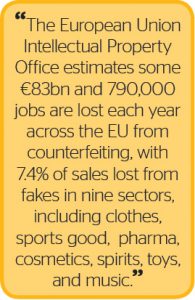 Counterfeit goods have a huge financial impact on brand reputation and customer perception but a pleasing aesthetic remains vital, he said. “Now, whilst there are lots of great options available that add security to a package, they all too often impact on design and take away from the stylish look of the product and that all important shelf stand out,” he added.
Counterfeit goods have a huge financial impact on brand reputation and customer perception but a pleasing aesthetic remains vital, he said. “Now, whilst there are lots of great options available that add security to a package, they all too often impact on design and take away from the stylish look of the product and that all important shelf stand out,” he added.
With medicines, toys, or spare parts, for example, inferior-quality fakes put health and safely at risk. Meanwhile the rapid growth of e-commerce makes it easier for counterfeiters to get to the consumer and by-pass checks. It is estimated that one in six online shoppers are duped by online counterfeits.
Bruyneel points to the range of methods to protect brands. “There are a number of options out there for adding security and verification tools to packaging, but those we have a particular fondness for are the ones that take into account the aesthetics of the design as well,” he said.
“Now, whilst many of these security features are perfect for high-end luxury goods (things like intricate holograms, foiling, inclusions in the paperboard and the like), they can be cost and time prohibitive for more general applications. To help businesses battle against counterfeiting and protect their valuable brand reputation, Agfa Graphics has developed high-end security and authenticity verification software that allows all packaging producers to get clever with their security, yet retain that eye catching symmetry that makes consumers pick the product up.
“Agfa’s Arziro Design is a powerful security design tool that sits alongside Arziro Authenticate, innovative software as a service solution that generates secure, copy-proof QR+ codes. The ultimate goal of the Arziro solutions is to make the job of counterfeiters as tough as possible by pushing the limits of design, creativity, and surveillance. Arziro Design enables the creation of complex, intricate, and hardto- copy designs that discourage forgers from attacking a brand, simply because these security features are too time consuming and costly for forgers to imitate.”
Kodak is also presenting brand protection solutions to prevent counterfeiters using new technologies to replicate packaging or alter serial numbers. Kodak’s portfolio offers a wide range of solutions that can be used independently or combined to create a multi-layered solution.
Through the Kodak Traceless AD System, packaging printers can easily add invisible serialisation to package, labels, or products detectable only by handheld Kodak Readers. Formulated for continuous inkjet printers, the technology enables authentication marks to be added easily and securely at a second print station inline in an existing packaging line.
The Kodak Traceless Ultracovert System, designed for ultra-high security anti-counterfeiting, is an authentication marker provided in a brand owner’s ink or varnish. Used by a number of pharmaceutical manufacturers, the security varnish concentrate is added to the overcoat varnish normally used. Flexo, offset, or other options are available. Kodak Traceless Ultracovert Readers are then used to inspect product in the office or out in the field.
Kodak’s Traceless Anywhere System combines proprietary marker material with a discreet, handheld reader to uncover illegally marketed products and merchandise. The marker material can be used on a wide range of material types including plastics and foils.


